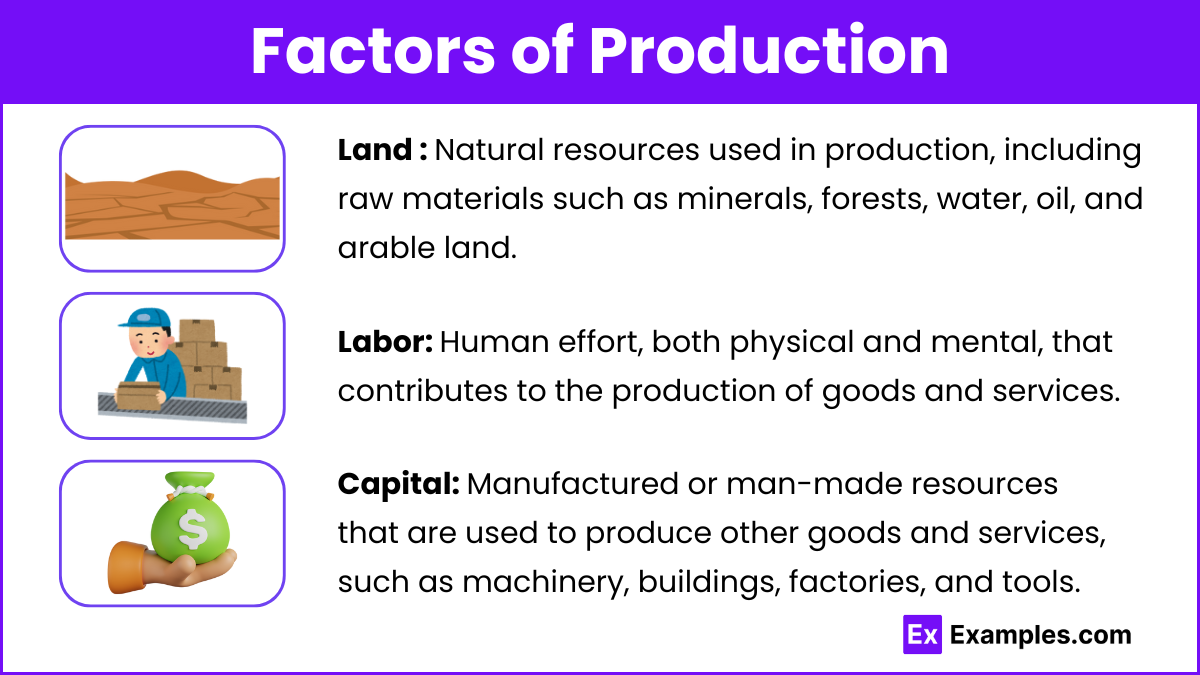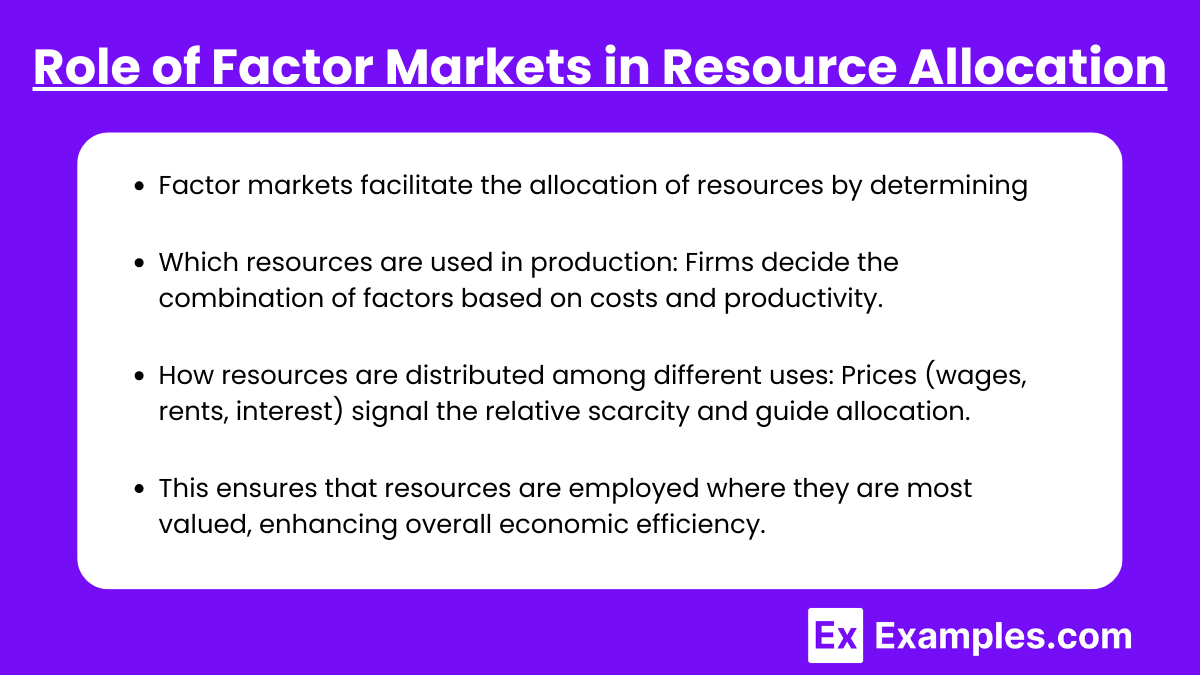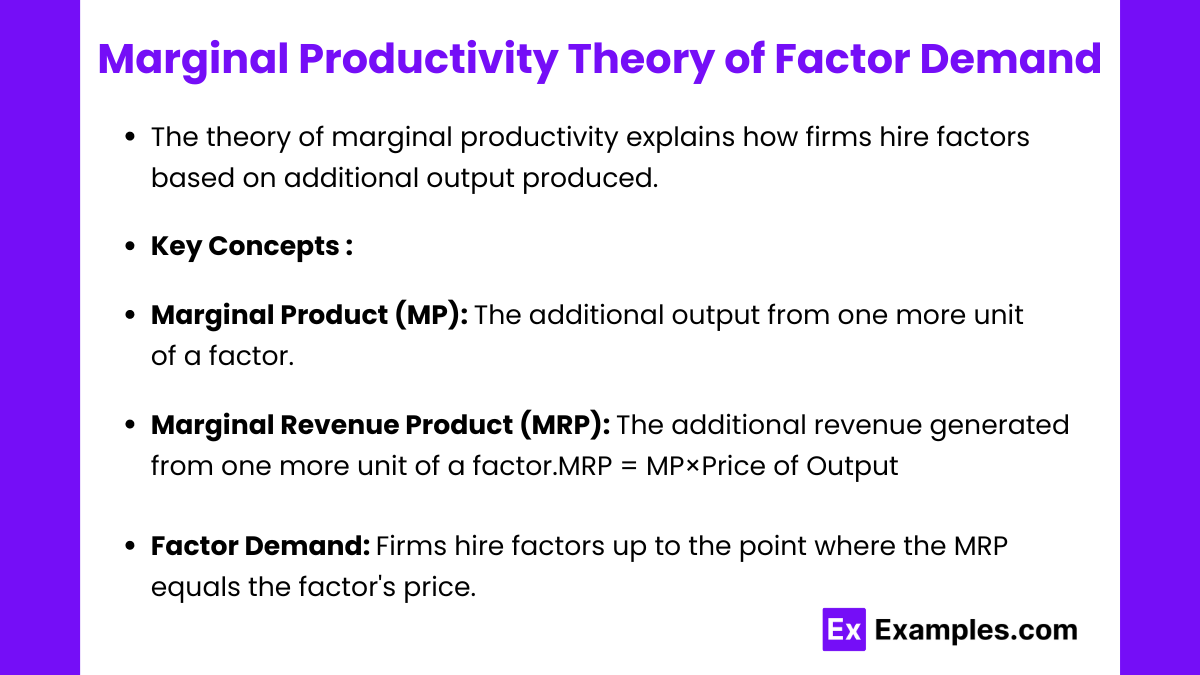In AP Microeconomics, factor markets are essential for understanding how the economy allocates resources. These markets facilitate the exchange of factors of production—such as labor, capital, land, and entrepreneurship—between households and firms. By determining the prices of these inputs, factor markets influence income distribution and production decisions. Studying factor markets in AP Microeconomics helps students grasp how businesses obtain the necessary resources to produce goods and services, and how these interactions affect overall economic efficiency and growth.
Learning Objectives
When studying “Introduction to Factor Markets” for AP Microeconomics, you should understand the definition and significance of factor markets as venues for buying and selling resources like labor, capital, land, and entrepreneurship. Grasp how derived demand links factor demand to product demand and apply the marginal productivity theory to determine factor prices. Analyze how supply and demand interact to establish equilibrium in factor markets, including wage determination. Recognize different market structures such as perfect competition and monopsony, and evaluate their effects on efficiency and income distribution. Additionally, be proficient in using relevant diagrams to illustrate these concepts.
1. Definition of Factor Markets

Factor markets are economic markets where resources (factors of production) such as labor, capital, land, and entrepreneurship are exchanged. Unlike product markets, where goods and services are bought and sold, factor markets deal with the inputs required to produce those goods and services.
Key Components:
- Buyers: Firms and businesses that demand factors of production.
- Sellers: Households and individuals who supply these factors.
- Prices: Wages (for labor), rent (for land), interest (for capital), and profits (for entrepreneurship).
2. Factors of Production

Understanding factor markets begins with identifying the four primary factors of production:
- Land: Natural resources used in production (e.g., minerals, forests, water).Natural resources used in production, including raw materials such as minerals, forests, water, oil, and arable land. These resources are either consumed directly in production or serve as essential inputs to create goods and services
- Labor: Human effort (physical and mental) used in production. Human effort, both physical and mental, that contributes to the production of goods and services.This includes manual labor, skilled professionals, and intellectual contributions.
- Capital: Manufactured resources (e.g., machinery, buildings, tools). Manufactured or man-made resources that are used to produce other goods and services, such as machinery, buildings, factories, and tools. Capital can be physical, such as equipment and infrastructure, or financial, including investments that facilitate future production.
Note: Some models include technology as a separate factor, but traditionally, it’s considered part of capital or entrepreneurship.
3. Role of Factor Markets in Resource Allocation

Factor markets facilitate the allocation of resources by determining:
- Which resources are used in production: Firms decide the combination of factors based on costs and productivity.
- How resources are distributed among different uses: Prices (wages, rents, interest) signal the relative scarcity and guide allocation.
This ensures that resources are employed where they are most valued, enhancing overall economic efficiency.
4. Derived Demand

Derived demand refers to the demand for a factor of production that arises from the demand for the goods and services it helps produce.
Key Points:
- Demand for factors depends on the demand for final products.
- For example, if there is an increase in the demand for automobiles, the demand for labor in car manufacturing increases.
Graphical Representation:
Imagine a product market where an increase in demand shifts the firm’s product demand curve to the right, leading to an increased demand for labor in the factor market.
5. Marginal Productivity Theory of Factor Demand

This theory explains how firms decide how much of each factor to hire. It is based on the concept of marginal productivity, which is the additional output generated by employing one more unit of a factor.
Key Concepts:
- Marginal Product (MP): The additional output from one more unit of a factor.
- Marginal Revenue Product (MRP): The additional revenue generated from one more unit of a factor.MRP = MP×Price of Output
- Factor Demand: Firms hire factors up to the point where the MRP equals the factor’s price.
Examples
Example 1. Labor Market in the Technology Sector
In the technology sector, the labor market is a prime example of a factor market where skilled labor is both demanded and supplied. Tech companies like Google, Apple, and Microsoft seek highly specialized employees such as software engineers, data scientists, and cybersecurity experts. These firms demand labor based on the marginal productivity of these workers—their ability to develop innovative products, improve existing technologies, and maintain competitive advantages. On the supply side, individuals with advanced degrees in computer science, engineering, and related fields supply their labor in exchange for wages and benefits. The equilibrium wage in this factor market is determined by the intersection of the demand from tech firms and the supply from skilled workers. Additionally, factors such as the rapid pace of technological advancement and the scarcity of specialized skills can lead to higher wages and increased competition among firms to attract top talent.
Example 2. Capital Market for Manufacturing Equipment
The capital market is another essential factor market where businesses acquire capital goods like machinery, equipment, and technology necessary for production. For instance, an automobile manufacturer requires significant investment in assembly line robots, stamping machines, and quality control systems. These capital goods are supplied by firms specializing in industrial machinery and technology providers. The demand for capital is driven by the need to enhance productivity, reduce labor costs, and improve product quality. Suppliers of capital goods set prices based on factors such as production costs, technological innovations, and market demand. The equilibrium price of capital reflects the cost of borrowing or investing in machinery, influencing the manufacturer’s decision on how much capital to utilize. Fluctuations in interest rates and technological breakthroughs can shift both the supply and demand curves in the capital market, affecting the overall investment levels within the manufacturing sector.
Example 3. Land Market for Agricultural Use
The land market exemplifies a factor market where natural resources are bought and sold for agricultural production. Farmers purchase or lease land to cultivate crops, raise livestock, and engage in other agricultural activities. The price of land, often referred to as rent, is influenced by factors such as soil fertility, climate conditions, location, and availability of water resources. Agricultural firms demand land based on the productivity it offers, which directly affects their output and profitability. Conversely, landowners supply their land for use in exchange for rent. The equilibrium price of land is determined by the balance between the demand from farmers and the supply from landowners. Changes in agricultural policies, environmental regulations, or shifts in crop demand can impact the land market, altering land prices and influencing farmers’ production decisions.
Example 4. Entrepreneurship Market in the Startup Ecosystem
Entrepreneurship represents a unique factor of production involving individuals who organize resources, take risks, and innovate to create new businesses. In the startup ecosystem, entrepreneurs play a crucial role in driving economic growth and technological advancement. They seek various factors of production, including labor, capital, and sometimes land, to establish and grow their ventures. Investors and venture capitalists supply the necessary capital by funding startups in exchange for equity or future returns. The demand for entrepreneurial talent is driven by the potential for high returns, market opportunities, and the ability to disrupt existing industries. Conversely, the supply of entrepreneurs is influenced by factors such as access to education, cultural attitudes towards risk-taking, and the availability of support systems like incubators and accelerators. The equilibrium in this factor market is achieved when the number of entrepreneurs willing to start new ventures matches the available investment capital, fostering a dynamic environment for innovation and business creation.
Example 5. Real Estate Market for Commercial Spaces
The real estate market for commercial spaces serves as an example of a factor market where businesses acquire land and buildings for operational purposes. Companies require office spaces, retail storefronts, warehouses, and manufacturing facilities to conduct their activities. Real estate developers and property owners supply these commercial properties, setting prices based on location, size, amenities, and market demand. Businesses demand commercial real estate based on their operational needs, growth plans, and cost considerations. For instance, a retail chain expanding into new cities will increase the demand for storefronts in prime shopping districts, driving up rental prices in those areas. Conversely, an oversupply of commercial spaces in a particular region can lead to lower rents and increased vacancies. The equilibrium price in the commercial real estate market is determined by the interplay between the demand from businesses and the supply from property owners, influenced by economic conditions, urban development trends, and regulatory policies.
Multiple Choice questions
Question 1
In a factor market, the demand for labor is considered:
A) Direct demand
B) Derived demand
C) Elastic demand
D) Inelastic demand
Answer: B) Derived demand
Explanation: In factor markets, the demand for labor is called derived demand because it depends on the demand for the goods and services that labor helps produce. For example, if there is high demand for cars, there will be an increase in demand for labor in car manufacturing. Derived demand connects the demand for factors of production to the final output being produced, distinguishing it from direct demand, which refers to goods and services consumed directly by households.
Question 2
Which of the following best explains why firms hire additional workers in a competitive labor market?
A) Firms continue hiring workers as long as the marginal revenue product (MRP) exceeds the wage.
B) Firms hire workers up to the point where marginal product (MP) equals average product (AP).
C) Firms will hire workers until the total revenue is maximized.
D) Firms will hire workers until marginal cost equals average total cost.
Answer: A) Firms continue hiring workers as long as the marginal revenue product (MRP) exceeds the wage.
Explanation: In a competitive labor market, firms hire additional workers as long as the marginal revenue product (MRP), or the additional revenue generated by one more worker, exceeds the wage that the worker is paid. The optimal point for hiring is when the MRP equals the wage. If the MRP is greater than the wage, the firm can increase profit by hiring more workers. If MRP falls below the wage, hiring additional workers would reduce profit.
Question 3
In a perfectly competitive labor market, the wage rate is determined by:
A) The firm’s demand for labor.
B) The intersection of market demand and market supply for labor.
C) The government’s minimum wage laws.
D) The marginal cost of capital.
Answer: B) The intersection of market demand and market supply for labor.
Explanation: In a perfectly competitive labor market, the wage rate is determined by the interaction of the market demand and market supply for labor. The market demand for labor comes from firms that need workers, while the supply of labor comes from individuals willing to work at various wage levels. The equilibrium wage rate is where the quantity of labor demanded equals the quantity of labor supplied. While government regulations (such as minimum wage laws) can influence wages, the fundamental wage-setting mechanism in a competitive market is the demand and supply balance.

